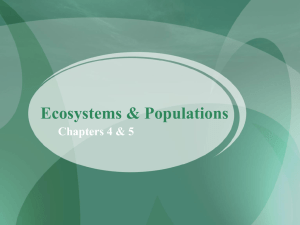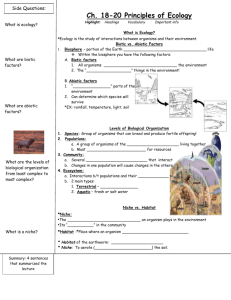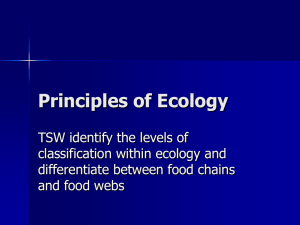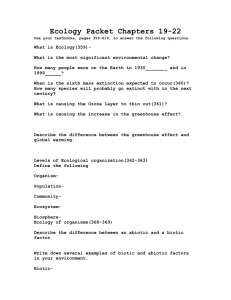Business of life and physiology 1
advertisement
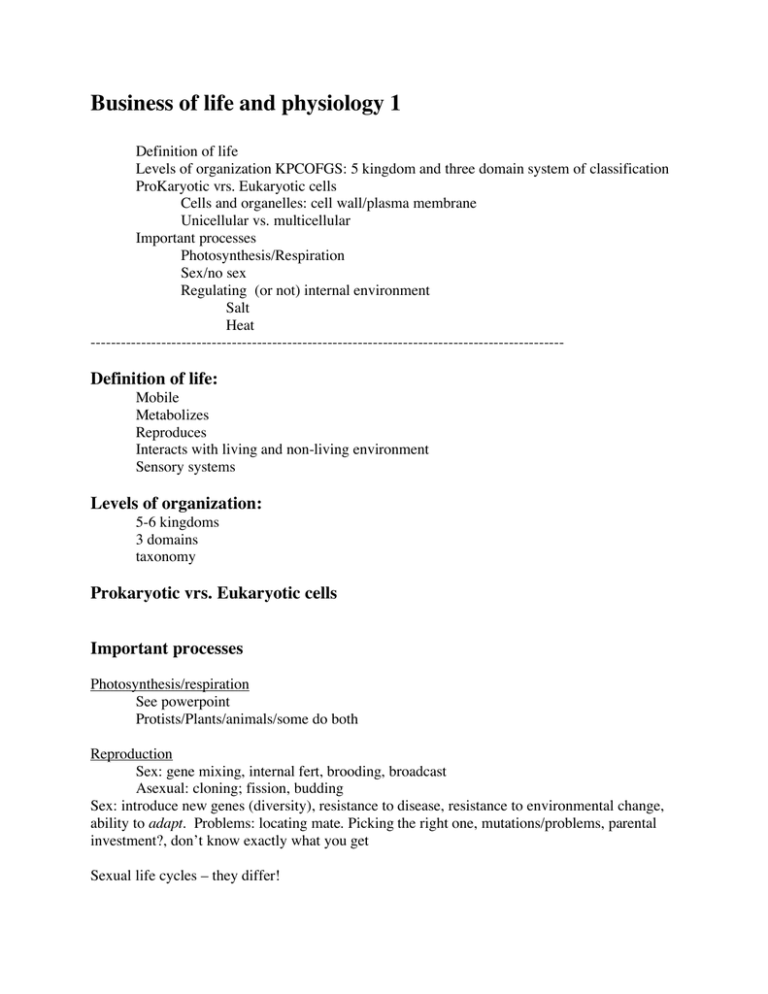
Business of life and physiology 1 Definition of life Levels of organization KPCOFGS: 5 kingdom and three domain system of classification ProKaryotic vrs. Eukaryotic cells Cells and organelles: cell wall/plasma membrane Unicellular vs. multicellular Important processes Photosynthesis/Respiration Sex/no sex Regulating (or not) internal environment Salt Heat ---------------------------------------------------------------------------------------------- Definition of life: Mobile Metabolizes Reproduces Interacts with living and non-living environment Sensory systems Levels of organization: 5-6 kingdoms 3 domains taxonomy Prokaryotic vrs. Eukaryotic cells Important processes Photosynthesis/respiration See powerpoint Protists/Plants/animals/some do both Reproduction Sex: gene mixing, internal fert, brooding, broadcast Asexual: cloning; fission, budding Sex: introduce new genes (diversity), resistance to disease, resistance to environmental change, ability to adapt. Problems: locating mate. Picking the right one, mutations/problems, parental investment?, don’t know exactly what you get Sexual life cycles – they differ! Asexual: fast, know what you get, can spread exact genes, cover an area quickly, no need to find a mate! Some can do both: asexual and sexual reproduction Hermaphroditism: sequential and simultaneous – both sexes in one individual Homeostasis: regulating internal environment Selective permeability: Salinity affects on organisms – Diffusion – molecules moving from an area of [high] to [low] – cell!! Osmosis – diffusion of water across a selectively permeable membrane Osmoregulators: Isosmotic (sea cucumbers)-same as outside Hyperosmotic (saltier inside) – fresh water fish Hypoosmotic – saltier outside – salt water fish Osmotic pressure Anadramous fish: probs! Osmoconformers – change with the salinity of envt Osmoregulation – control internal concentration – excretion of urea, urine, Temperature – Ectotherms or "poikilotherms" = cold blooded – change with surrounding temperature and effects on the metabolism rate. Endotherms or homeotherms = warm blooded – maintain a relatively constant body temperature through respiration. Surface to volume ratio S/V – determines how fast materials and heat diffuse in/out – SIZE: Larger orgnisms have a smaller S/V so develop supplementary mechanisms to deal with materials and heat – like respiratory and excretory systems. Business of life 2: Principles in Ecology and Symbiosis Productivity/ biogeochemical cycles Food webs Ecology: species, populations, communities Types of living Evolution/natural selection/adaptation Community structure Populations – what affects them Species interactions: symbiosis Community processes Marine Vrs. Terrestrial Productivity – where the energy comes from to fuel these food webs Productivity – rate of primary production – amount of carbon fixed / m2 sea surface / day or year. Photosynthesis – CO2 + H2O + sun energy > organic matter + O2 , need chlorophyll!! Respiration – Organic matter + O2 > CO2 + H2O + energy Biogeochem cycles: what are they and why imp?? Food webs: AUTO– and HETEROTROPHS: trophic relationships Main types of organisms that make up these groups: Autotrophs : organisms that build their own carbohydrates, proteins using only water, sunlight and inorganics material – nitrates and phosphates. Also termed primary producers. 6H2O + 6CO2 = C6H12O6 + 6O2 Plants – photosynthesize – take up CO2 and produce O2. Marine are called algae. Chemosynthesis – autotrophs that do not use sunlight but use chemicals Heterotrophs: Organisms that must obtain their food from other organisms and are not self sufficient. Types – Herbivore – Omnivore – Carnivore. eggs Invertebrates – 97% of all species are invertebrates – animals with no backbone. Fishes – vertebrates, three groups =jawless, bony, and cartilaginous. Birds – warm blooded vertebrates with feathers, light bones, fly Mammals– vertebrates, warm blooded, with hair, viviparous, mammary glands Reptiles – vertebrates, air breathing, cold blooded,skin is covered with scales and lay on land. Decomposers FOOD CHAINS/WEBS – Fig. = pyramid o 1 Producer – 1o consumer – 2o consumer – 3o consumer : Decomposers break down organic compounds at every level – detritus = bacteria and fungi break down material into dead organic matter. Succeeding trophic levels define the trophic structure. 10% of the energy is passed from one level to another, resulting in energy and biomass pyramids Biological magnification: when toxins from low levels in the food chain are concentrated as one goes up the food chain. Nearly 100% of the toxin is often passed on. Species interactions: symbiosis Community processes Ecology: species, populations, communities Ecology – the scientific study of the interactions that determine the distribution and abundance of organisms. Derived from the greek word oikos = house or place to live and ology. The study of ecosystems, populations, and organisms fall within the realm of ecology. As we go from mmoleculestowards biosphere there is a decrease in scientific understanding. Discuss whole organism approach vs. molecular and applications of mol. bio.to populations. Species – a genetically distinct organism that can not interbreed with Population – is a group of these organisms of the same kind. Community – is a group of populations of species that occupy the same habitat. Characteristics of communities are that the populations interact. Eg. intertidal, kelpforest Ecosystem – a group of communities that interact with eachother and nonliving parts of the environment. Eg. Ocean, rainforest, alpine Types of living (plants and animals) related to zones in the ocean Spatial and Temporal scales Sessile (benthos) – attached to one place, usually benthic – bottom dwelling organisms that life on all types of substrates or benthos – bottom types = sand, rock or mud or other biotic material. (Epifauna, infauna) Many are suspension feeders Pelagic – live up in the water column , away from the bottom. Planktonic – Drifting and floating organisms that move with wind and currents. Many organisms have a stage in their life cycle that is planktonic. Phytoplankton, zooplankton Nekton – swimming forms, include fish Evolution/Natural Selection/Adaptation: Evolution –process by which species acquire certain adaptations. Natural Selection – the mechanism by which evolution occurs. Acts on individuals but influences that characteristics of a population. Genotype –adaptations are passed on through generations through genes. Phenotype – the physical manifestation of the genetically inherited traits. Community Structure: Habitat –the micro environment a species inhabits. Eg. Tidepool or open ocean Niche – position in the habitat that the species occupies. Influenced by physical environment and the interactions with other species. EG. Feeding diversity in fishes (whale shark, parrot fish, blenny, lizard fish, shark, damsel). Categories of niches: Predator, Prey, Parasites, Herbivores are special predators on sessile creatures. Competitive Exclusion Principle (CEP): no two species can have the same niche requirements and persist for a long time when resources are limited– two outcomes 1)extinction 2)niche divergence. Ecological Niche Equivalents – different habitat, same role E.G. Auk vs. penguin Factors that affect niche development: Biotic – portion of habitat influenced by other living organisms. Abiotic – non living (physical and chemical) portion of habitat affecting what lives there. Generalists – occur in areas of low species abundance. Specialists occur in areas where species are packed together. E.G. Coral reef. Populations: what affects them? What affects the size of populations or population growth? Density (#/area) = size Natality – birth rate Mortality – death rate Age distribution Distribution in space – uniform, random, clumped Resources – limiting resources Species interactions Species Interactions Parasitism, herbivory, predation and competition – for food, light, and space. Competition – for a limited resource. Can be intra specific (stronger) or inter specific (weaker). EG. Competitive exclusion – when one wins Resource partitioning – sharing a resource *** leads to niche formation!! Predation – when an organism eats another. Predator and prey – carnivore/herbivore/omnivore Symbiosis – 2 difft. organisms that live in close association – co–evolved – symbiont and host. At least one benefits Mutualism: both benefit Parasitism – Community Processes: Communities are named after dominant component: on land usually plants, in water usually animals. Ecotones – boundaries between communities Species richness– number of species in a given area Species diversity – Combines species richness and evenness (distribution of total number of individuals among species. Succession – change in species present in a community over time. Early colonizers to terminal species (climax community) Diversity – 2 schools of thought Equilibrium theory– stability of climax community allows evolution to fine niches. Succession occurs at late stages Intermediate disturbance hypothesis– frequent disturbance doesn't allow for climax community – excludes specialists, generalists prevail = mid successional stages persist. MARINE vs. TERRESTRIAL Water benefits: Lack of gravity allows for massive body size with little or no skeleton – whales, jellyfish Currents carry food so filter feeders (suspension feeders) can survive and disperse young. Stable temperatures – adaptations to fluxuations less important. Cost of locomotion is cheaper, but need streamlining Water costs: Oxygen is more limited and fluxuates related to temperature. Water absorbes light and limits the photic zone to 100m. Land: Plants form dominant member of community, in oceans animals normally do – exceptions are kelp forests or seagrass communities. Most algae are microscopic and have small herbivores Terrestrial plants – woody, structural support, protection from grazing Trophic levels – generally more in the ocean than land due to microscopic organisms. Land – grass – deer – mountain lion Ocean – phytoplankton – small zooplankton – large zooplankton – herring –squid – big fish – seal – Orca
